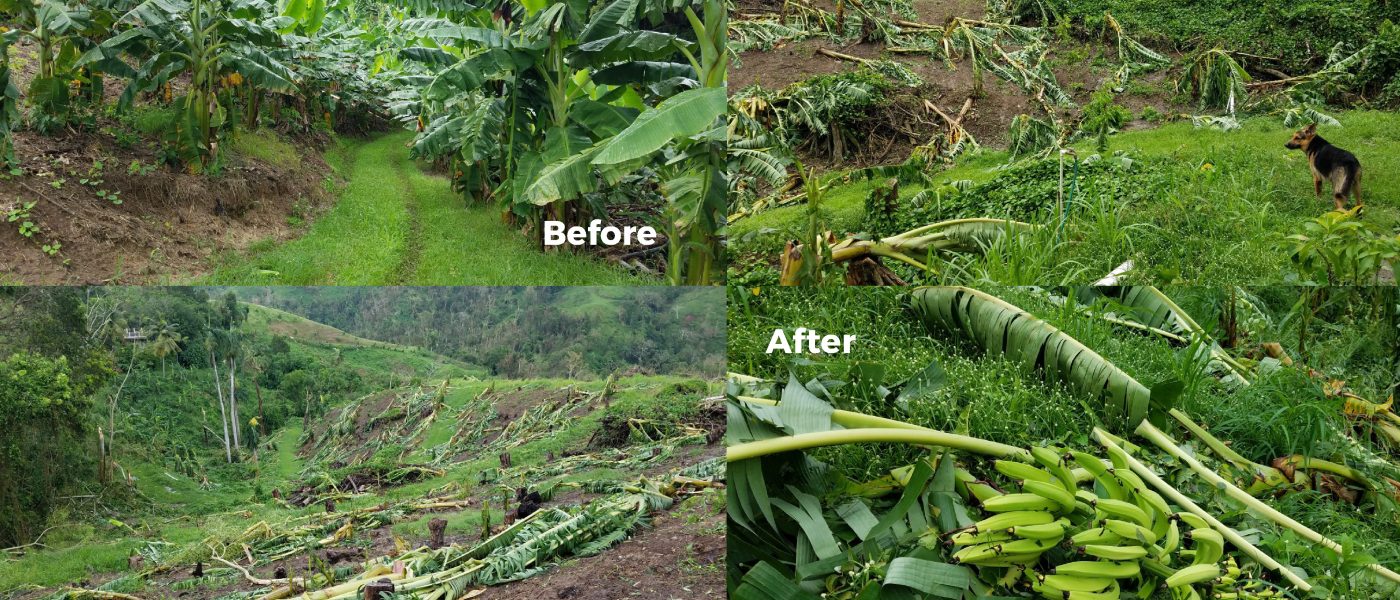Reviewing the list of the 20 farmers in Puerto Rico who have received grants from our Family Farm Disaster Fund so far is powerful, knowing that they and their families made it through the horror of Hurricane Maria and are fighting to rebuild. Each one of their stories gives us hope as we hear of the ongoing devastation in Puerto Rico. We will share those stories as our incredible partners at Visit Rico are able to prioritize material collection.
In the wake of natural disasters that affect farmers, Farm Aid opens the Family Farm Disaster Fund so that folks can make a donation and know that every penny reaches farmers in their efforts to rebuild. Farm Aid has operated the Family Farm Disaster Fund since 1993, when terrible flooding wiped out farms across the Midwest. Having just started my job with Farm Aid in August, it was a bit overwhelming to be one of the people charged with upholding Farm Aid’s standards of being first on the scene with cash, support and expertise for farmers. Then all of the sudden we had five separate disasters hit several regions in the span of my first eight weeks.
This is why we lean on the courage and wisdom of our partners and advocates: the folks who run towards fires and floods and are almost always changed by what they find, but who just keep going in. In Puerto Rico, those people were Visit Rico staff, a new partner to us, as we never worked in Puerto Rico before. Shortly after the organization was selected as an anchor partner for our response, it became obvious that we made the right decision. While we wish this disaster did not happen, we are grateful for the opportunity to begin working on the ground in Puerto Rico with farmers who are passionate about good food, being the best stewards of the land, soil and water, teaching the next generation about the value of food and land, and working to strengthen the people of their island.
“Some [Puerto Rican farmers] held their hands up in resignation and some were bravely holding onto hope, but most were too busy helping others to think about themselves.”
Answering calls about Puerto Rico on the Farm Aid hotline, I recognized a desperation similar to many of our other hotline callers. Everyone in Puerto Rico–from folks at the local USDA offices, farmers of all sizes and types of agriculture, people working at foundations and farm organizations doing what they can to help–they all sound rough. Some held their hands up in resignation and some were bravely holding onto hope, but most were too busy helping others to think about themselves. The sense of solidarity among our partners across all of the disaster regions has been remarkable. The degree to which the most resource-limited farmers, farm organizations and agencies can work together to bring critical supplies to those in need has been overwhelming and positive. In Puerto Rico specifically, the solidarity and coordination of help has been truly remarkable given what they’re up against. I’ve had several difficult conversations with partners about suicide prevention and the use of the farmer guides to navigate federal disaster programs as a way to give farmers hope for the future. These are the enduring realities of disaster work after the immediate response effort has passed–realities that Farm Aid knows well.
Hurricane Maria came at a time when these young (mostly female) leaders of Puerto Rico’s agricultural revival were gaining steam in shaping a sustainable economy around the island’s five regional farmers’ markets, supporting lots of new farmers and creating relevant jobs. The devastation of Hurricane Maria almost feels more cruel knowing that this economic future based on sustainable agriculture seemed so hopeful before. It is very hard to accept that none of us have the necessary capacity, money or tools at our collective disposal to immediately help the island prove the potential model.
Heartbreaking as this is, supporting Puerto Rico’s farmers to rebuild can actually have a huge impact on the island’s ability to keep its farmers and farm-based economy growing, and in the process learn how to better model farm disaster responses in a way that builds more resiliency. I am hoping for fewer opportunities to apply these lessons, but let’s be honest: natural disasters are not going away and we need to be paying attention to them.
Despite feeling overwhelmed and under-resourced we feel lucky to do this work and share our lessons as we come up for air. Here are some highlights that get us through, and why I’m grateful for Farm Aid:
- Our partners share our focus on high standards of speed, integrity and impact of the work. We also share a clear line of open communication so that if flexibility is needed, we are ahead of it.
- There is a huge sense of solidarity among Farm Aid and the local groups working together and diving into the same mess with creative collaborations, despite very limited resources.
- Our network of brilliant, seasoned advocates at the local and national level (Farmers’ Legal Action Group and Rural Advancement Foundation International to name two) prioritized the creation of farmer disaster resource guides available in both English and Spanish to each disaster-impacted region.
- Last, but not least, a big part of what is exactly right about Farm Aid’s approach is that it’s rooted in the ever-present spirit of Willie Nelson and the other Board Artists who keep us all asking, “how can I help?”
I know how you can help: give a gift today. Thank you!
Help us keep the Family Farm Disaster Fund strong!




